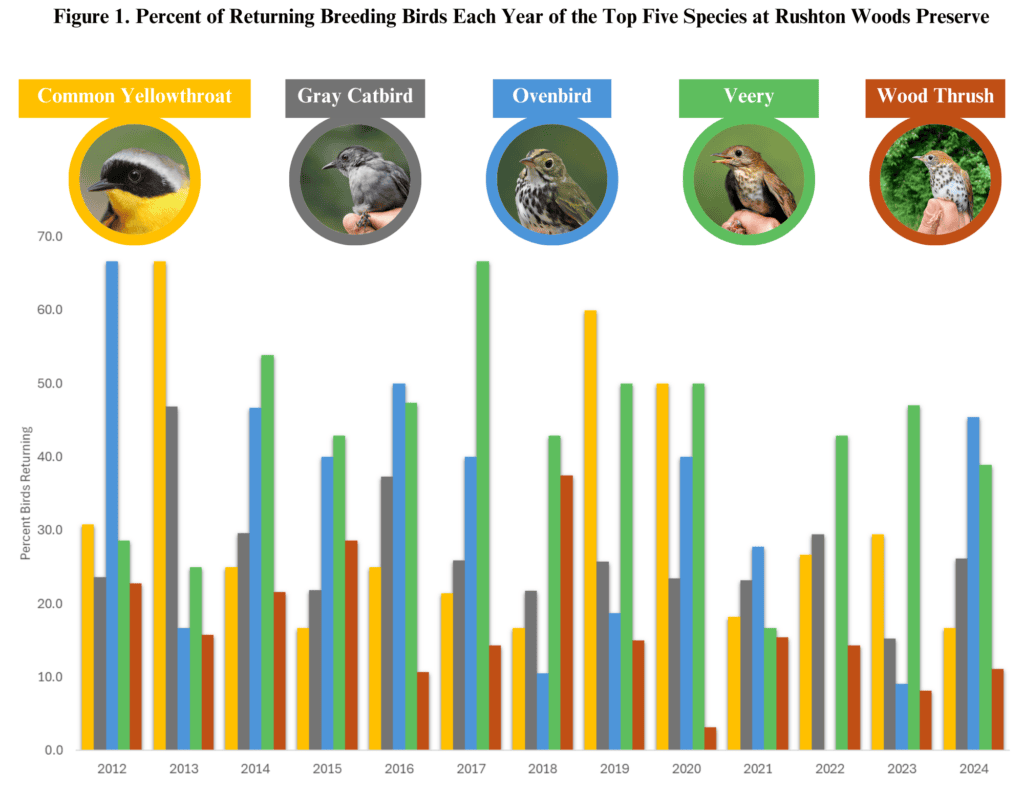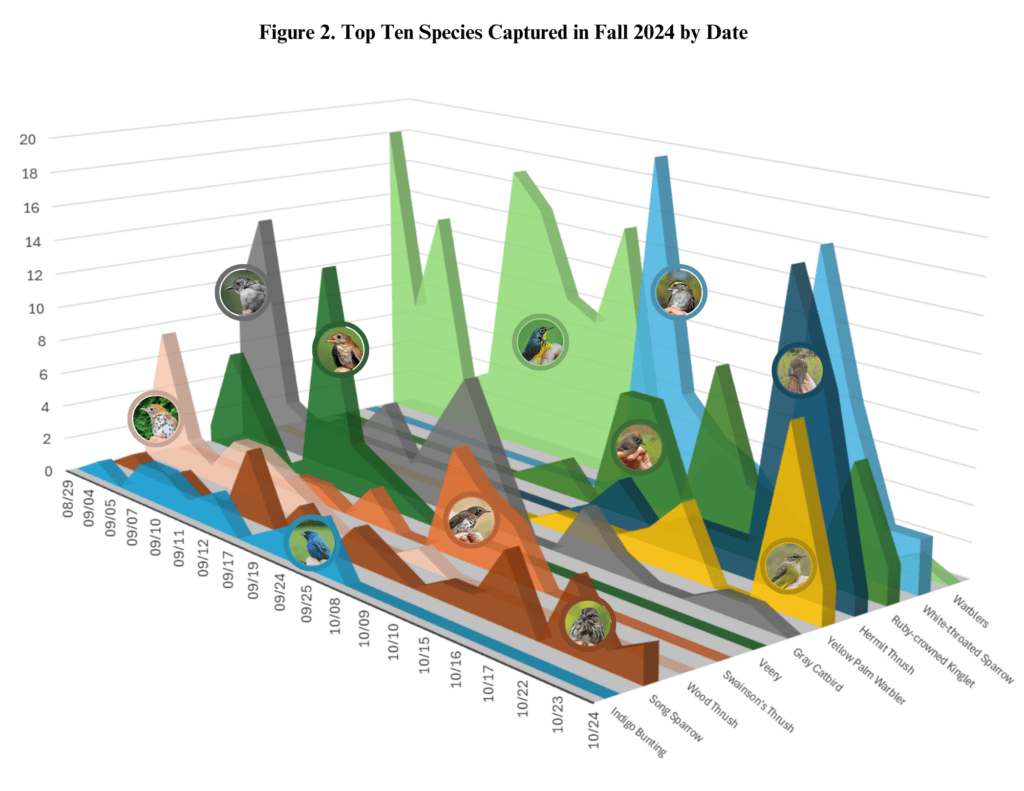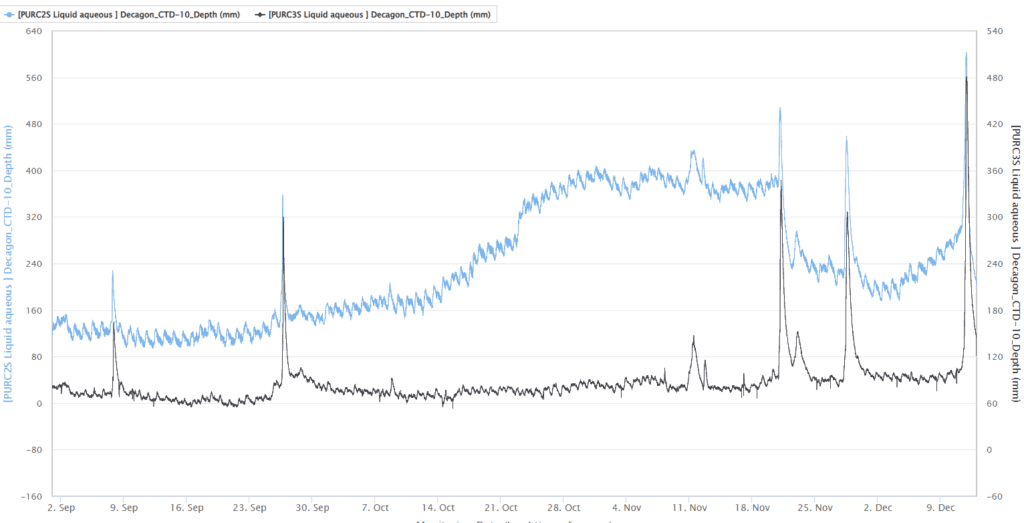The Fruits of Our Labors
By: Bird Program Staff
It’s hard to believe that fifteen years have passed since we first began studying the birds of Rushton Woods Preserve. Only a few years prior, Rushton Farm had been established by Fred de Long as one of the region’s first regenerative farms within a nature preserve owned by a land trust. At that time, most of the Willistown Conservation Trust’s board members were opposed to adding the farm to the heart of this 86-acre nature preserve. They believed farming occurs at the expense of wildlife; however, they soon discovered Fred was an organic farmer committed to proving that agriculture can serve as the baseline for wildlife conservation. Today Rushton Farm is not only the heart of the organization but also a nationwide model of regenerative agriculture on conserved land.
The bird banding data we have collected over the years has allowed us to demonstrate the mutually beneficial relationship between regenerative farming and the surrounding ecosystem. We have now banded 20,830 individual birds of 104 species since 2010. These include songbirds using Rushton as a stopover habitat during migration, as breeding territory, as a year-round residence, or as wintering grounds.
With so many years of data gathered, we can now begin focusing on trends. We notice that spring and fall migrations look as if these bird populations are in decline, but our breeding bird populations (studied within the national MAPS program: Monitoring Avian Productivity and Survivorship) are increasing. This year, we focused on our birds returning with bands from previous years, a parameter that—while often overlooked—is becoming more prevalent in our long-term dataset.
Spring 2024
Spring started cold and quiet, with the bulk of our capture finally occurring in May. Capture rates remained similar to last spring, but overall they were the two lowest capture rates in station history. Diversity was also similarly low to the previous spring of 33 species. The species that continue to show significant declines are the Gray Catbirds and warbler species. We did capture our 20,000th bird this spring, which happened to be a Gray Catbird—still our most common species despite the declines.
The decline in warblers is mainly in the number of individuals rather than the diversity. For example, in 2022, we had the highest diversity of species, but the third lowest capture rate for warblers. The succession of our hedgerow habitat (i.e., trees growing taller and replacing shrubs) could contribute to catching fewer individuals as the canopy is getting higher; the canopy is where many warblers love to forage!
Focusing on the birds returning between years, the outlook is brighter. About 26% of all birds captured during spring migration 2024 were returning from previous years! In April alone, two White-throated Sparrows were our own recaptures — one from spring of 2022 and another from spring of 2023 — indicating that these individuals loyally return to Rushton each winter or use it as a reliable refueling site on their northbound journeys.
In terms of returning breeding birds, 16% of the Gray Catbirds and 36% of Common Yellowthroats sported bands from previous years. One of the catbirds was a recapture from 2018, making it about seven years old. Meanwhile, of the three Baltimore Orioles we caught, two already had their bracelets! Orioles in particular, love the edge habitat that the farm creates, and they can often be seen gregariously chasing each other across the airspace directly over the farm fields. In winter, they seek similar open habitat on shade-grown coffee farms in the tropics.
And let’s not forget the year-round residents of Rushton! Between-year recaptures included 50% of Tufted Titmice, 75% of Northern Cardinals, and 100% of Carolina Chickadees.
Spring banding ended with a warm spell that brought the highest diversity of the season, including an old Indigo Bunting originally banded in 2019, and a surprise Yellow-breasted Chat! Normally fairly flamboyant with an odd series of croaks, whistles, and short repeated phrases, this chat wasn’t chatting at all. If we had not caught the bird in a net, most likely we never would have known it was there. As one of our “life is messy” species, early successional shrub habitat (often perceived as messy) is its preference, which we embrace wholeheartedly at Rushton.
MAPS 2024
When we report the total number of birds each year, we often only report the total number of new birds, excluding recaptures. During migration, the recaptured birds are most often the same birds we banded within that season. The data we are acquiring from such recaptures is mostly how long the bird stayed at Rushton, or if it gained weight for its migratory journey, which can both be indicators of habitat quality. For example, one voracious Veery was determined to have gained 13% of its body weight in seven days of dining from the Rushton all-you-can-eat buffet! However, recaptures can be broken down into two categories: birds that we banded within that same season or year, and banded birds that are returning to Rushton from a previous year.
During the breeding season, songbirds often show high site fidelity, meaning that they will return to the same site from year to year to breed. They are more likely to do this if they were successful at breeding the previous year. This year, after 14 years of MAPS banding at Rushton Woods, we became concerned that some of our most common breeding birds were declining, like the Veery. However, after a closer look at the data, we can see that numbers of most of our birds are stable or showing normal fluctuations; we just had to take into account the birds that are returning each year!
Nearly 30% of our MAPS birds return each year to breed at Rushton Woods. Our top five most common birds captured are Gray Catbird, Common Yellowthroat, Ovenbird, Veery, and Wood Thrush (accounting for 75% of all birds banded). While it varies from year to year, we see a similar average rate of 30% returning birds of our top five species. Figure 1 shows the percent of return birds for each of the top five species each year. You can see that Common Yellowthroat, Ovenbird, and Veery are consistently returning at the highest rates; in some years as high as 66% of the birds of these three species are returning! Interestingly, Ovenbird and Veery are the only two ground nesters in this group, and both have high return rates. In particular, after thirteen years, an average of 42.5% of our total Veery population have returned to breed at Rushton!

Fall 2024
This fall was truly surreal. Typically our busiest banding season, we look forward to the waves of species groups coming in from week to week (Figure 2). This season started out slow and never really picked up like it normally does in September. We were seeing the usual suspects, but not the usual numbers of individuals. Where did all the catbirds go? We had the lowest capture rates ever documented of Gray Catbirds in spring and fall. This particularly concerning fall saw a 72% decrease in catbirds from last fall and a 75% decrease from our 14-year average.




